ignition VOLVO C30 2013 Owner´s Manual
[x] Cancel search | Manufacturer: VOLVO, Model Year: 2013, Model line: C30, Model: VOLVO C30 2013Pages: 300, PDF Size: 6.58 MB
Page 154 of 300
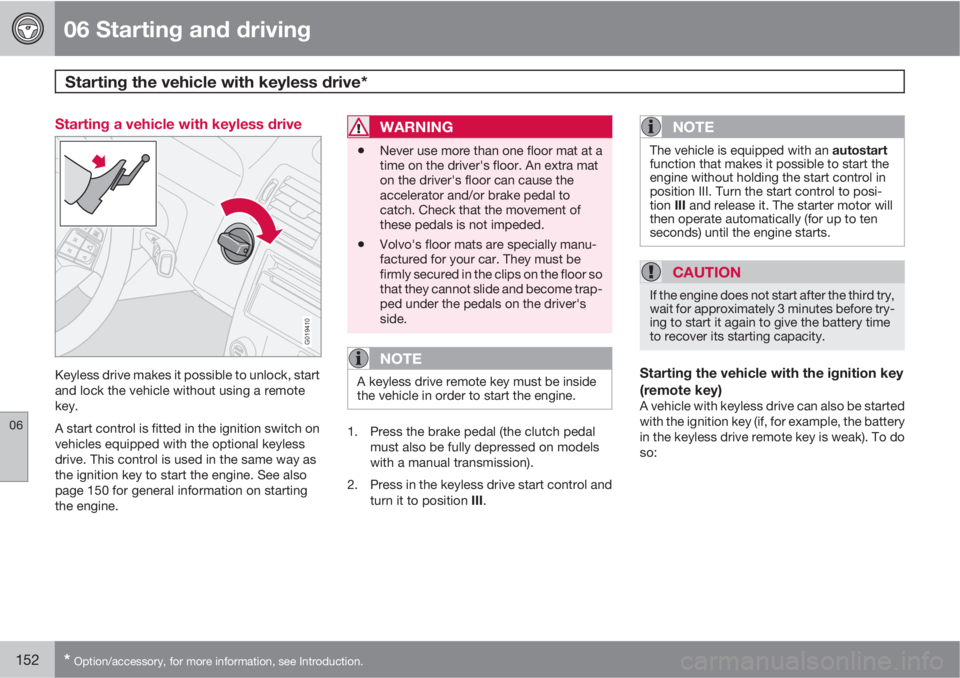
06 Starting and driving
Starting the vehicle with keyless drive*
06
152* Option/accessory, for more information, see Introduction.
Starting a vehicle with keyless drive
G019410
Keyless drive makes it possible to unlock, start
and lock the vehicle without using a remote
key.
A start control is fitted in the ignition switch on
vehicles equipped with the optional keyless
drive. This control is used in the same way as
the ignition key to start the engine. See also
page 150 for general information on starting
the engine.
WARNING
•Never use more than one floor mat at a
time on the driver's floor. An extra mat
on the driver's floor can cause the
accelerator and/or brake pedal to
catch. Check that the movement of
these pedals is not impeded.
•Volvo's floor mats are specially manu-
factured for your car. They must be
firmly secured in the clips on the floor so
that they cannot slide and become trap-
ped under the pedals on the driver's
side.
NOTE
A keyless drive remote key must be inside
the vehicle in order to start the engine.
1. Press the brake pedal (the clutch pedal
must also be fully depressed on models
with a manual transmission).
2. Press in the keyless drive start control and
turn it to position III.
NOTE
The vehicle is equipped with an autostart
function that makes it possible to start the
engine without holding the start control in
position III. Turn the start control to posi-
tion III and release it. The starter motor will
then operate automatically (for up to ten
seconds) until the engine starts.
CAUTION
If the engine does not start after the third try,
wait for approximately 3 minutes before try-
ing to start it again to give the battery time
to recover its starting capacity.
Starting the vehicle with the ignition key
(remote key)
A vehicle with keyless drive can also be started
with the ignition key (if, for example, the battery
in the keyless drive remote key is weak). To do
so:
Page 155 of 300
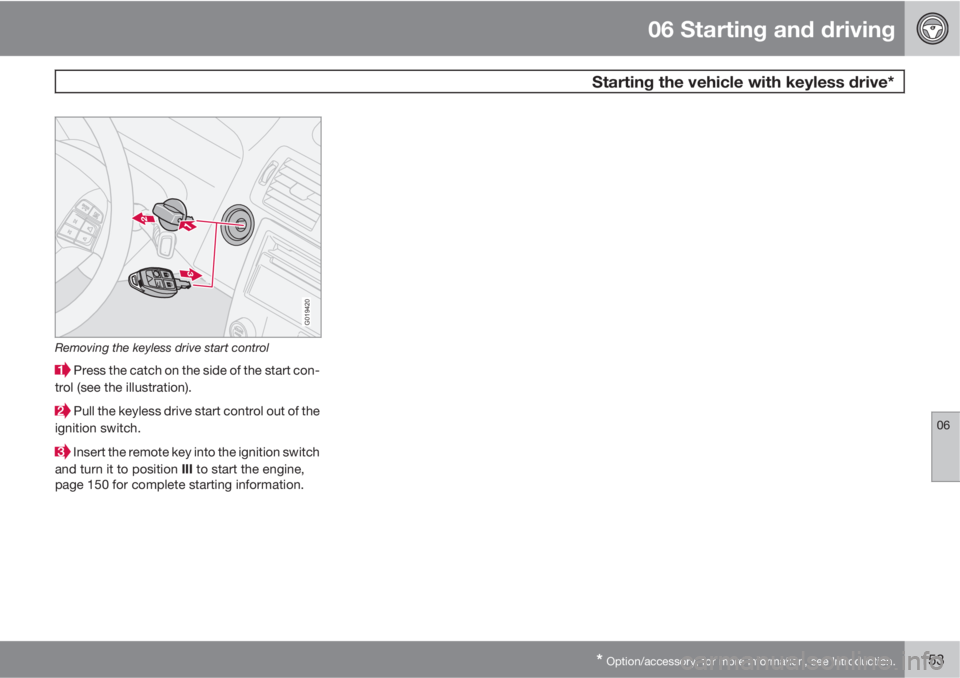
06 Starting and driving
Starting the vehicle with keyless drive*
06
* Option/accessory, for more information, see Introduction.153
G019420
Removing the keyless drive start control
Press the catch on the side of the start con-
trol (see the illustration).
Pull the keyless drive start control out of the
ignition switch.
Insert the remote key into the ignition switch
and turn it to position III to start the engine,
page 150 for complete starting information.
Page 158 of 300
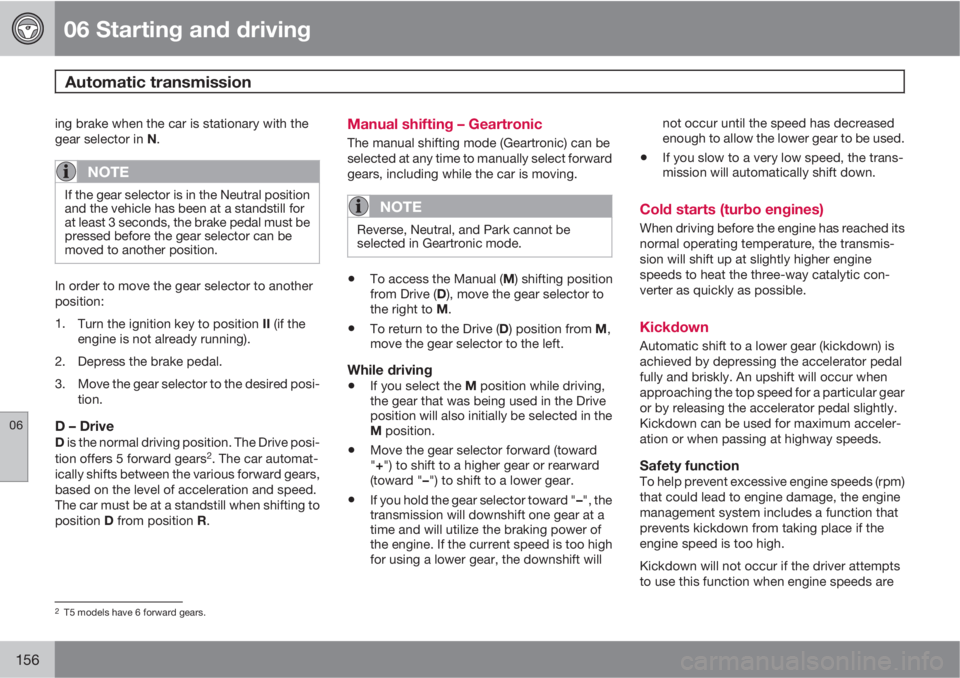
06 Starting and driving
Automatic transmission
06
156
ing brake when the car is stationary with the
gear selector in N.
NOTE
If the gear selector is in the Neutral position
and the vehicle has been at a standstill for
at least 3 seconds, the brake pedal must be
pressed before the gear selector can be
moved to another position.
In order to move the gear selector to another
position:
1.
Turn the ignition key to position II (if the
engine is not already running).
2. Depress the brake pedal.
3. Move the gear selector to the desired posi-
tion.
D – DriveD is the normal driving position. The Drive posi-
tion offers 5 forward gears2. The car automat-
ically shifts between the various forward gears,
based on the level of acceleration and speed.
The car must be at a standstill when shifting to
position D from position R.
Manual shifting – Geartronic
The manual shifting mode (Geartronic) can be
selected at any time to manually select forward
gears, including while the car is moving.
NOTE
Reverse, Neutral, and Park cannot be
selected in Geartronic mode.
•To access the Manual (M) shifting position
from Drive (D), move the gear selector to
the right to M.
•To return to the Drive (D) position from M,
move the gear selector to the left.
While driving
•If you select the M position while driving,
the gear that was being used in the Drive
position will also initially be selected in the
M position.
•Move the gear selector forward (toward
"+") to shift to a higher gear or rearward
(toward "–") to shift to a lower gear.
•If you hold the gear selector toward "–", the
transmission will downshift one gear at a
time and will utilize the braking power of
the engine. If the current speed is too high
for using a lower gear, the downshift willnot occur until the speed has decreased
enough to allow the lower gear to be used.
•If you slow to a very low speed, the trans-
mission will automatically shift down.
Cold starts (turbo engines)
When driving before the engine has reached its
normal operating temperature, the transmis-
sion will shift up at slightly higher engine
speeds to heat the three-way catalytic con-
verter as quickly as possible.
Kickdown
Automatic shift to a lower gear (kickdown) is
achieved by depressing the accelerator pedal
fully and briskly. An upshift will occur when
approaching the top speed for a particular gear
or by releasing the accelerator pedal slightly.
Kickdown can be used for maximum acceler-
ation or when passing at highway speeds.
Safety functionTo help prevent excessive engine speeds (rpm)
that could lead to engine damage, the engine
management system includes a function that
prevents kickdown from taking place if the
engine speed is too high.
Kickdown will not occur if the driver attempts
to use this function when engine speeds are
2T5 models have 6 forward gears.
Page 160 of 300
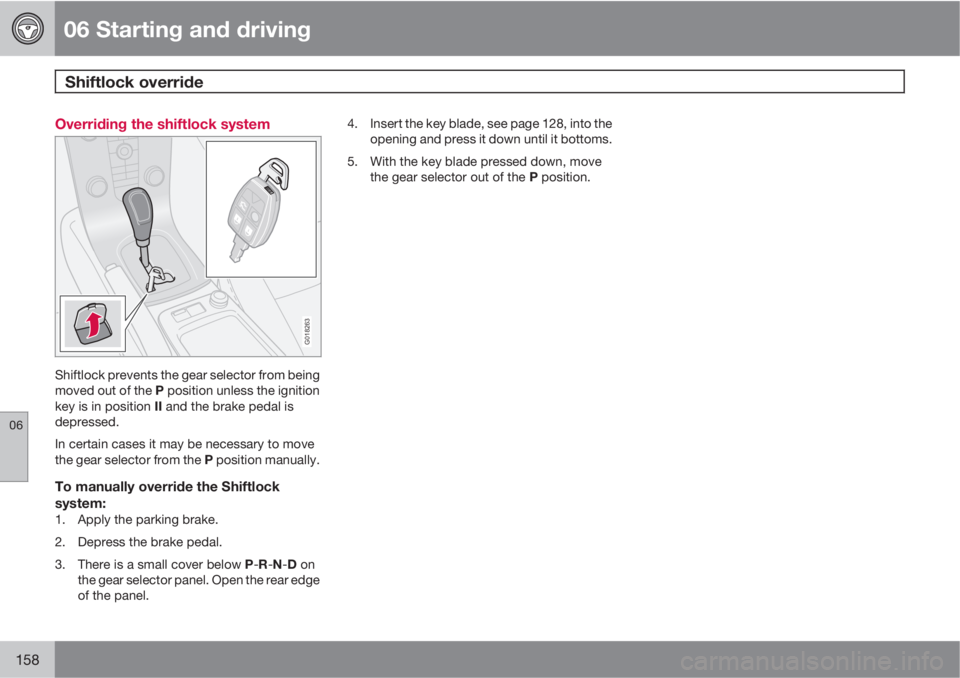
06 Starting and driving
Shiftlock override
06
158
Overriding the shiftlock system
G018263
Shiftlock prevents the gear selector from being
moved out of the P position unless the ignition
key is in position II and the brake pedal is
depressed.
In certain cases it may be necessary to move
the gear selector from the P position manually.
To manually override the Shiftlock
system:
1. Apply the parking brake.
2. Depress the brake pedal.
3.
There is a small cover below P-R-N-D on
the gear selector panel. Open the rear edge
of the panel.4. Insert the key blade, see page 128, into the
opening and press it down until it bottoms.
5. With the key blade pressed down, move
the gear selector out of the P position.
Page 168 of 300
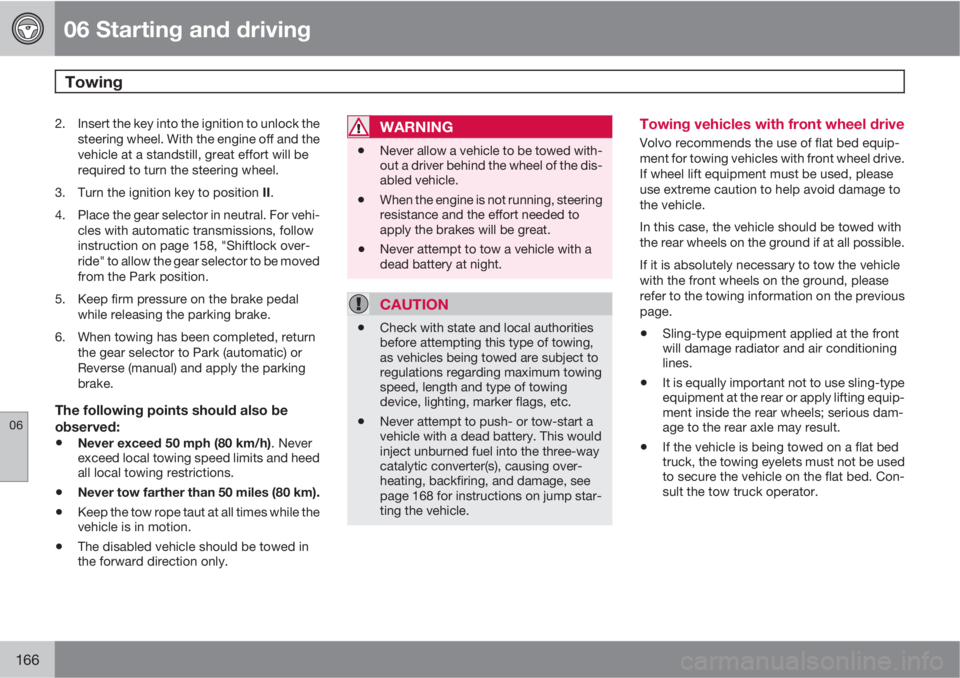
06 Starting and driving
Towing
06
166
2. Insert the key into the ignition to unlock the
steering wheel. With the engine off and the
vehicle at a standstill, great effort will be
required to turn the steering wheel.
3.
Turn the ignition key to position II.
4. Place the gear selector in neutral. For vehi-
cles with automatic transmissions, follow
instruction on page 158, "Shiftlock over-
ride" to allow the gear selector to be moved
from the Park position.
5. Keep firm pressure on the brake pedal
while releasing the parking brake.
6. When towing has been completed, return
the gear selector to Park (automatic) or
Reverse (manual) and apply the parking
brake.
The following points should also be
observed:
•Never exceed 50 mph (80 km/h). Never
exceed local towing speed limits and heed
all local towing restrictions.
•Never tow farther than 50 miles (80 km).
•Keep the tow rope taut at all times while the
vehicle is in motion.
•The disabled vehicle should be towed in
the forward direction only.
WARNING
•Never allow a vehicle to be towed with-
out a driver behind the wheel of the dis-
abled vehicle.
•When the engine is not running, steering
resistance and the effort needed to
apply the brakes will be great.
•Never attempt to tow a vehicle with a
dead battery at night.
CAUTION
•Check with state and local authorities
before attempting this type of towing,
as vehicles being towed are subject to
regulations regarding maximum towing
speed, length and type of towing
device, lighting, marker flags, etc.
•Never attempt to push- or tow-start a
vehicle with a dead battery. This would
inject unburned fuel into the three-way
catalytic converter(s), causing over-
heating, backfiring, and damage, see
page 168 for instructions on jump star-
ting the vehicle.
Towing vehicles with front wheel drive
Volvo recommends the use of flat bed equip-
ment for towing vehicles with front wheel drive.
If wheel lift equipment must be used, please
use extreme caution to help avoid damage to
the vehicle.
In this case, the vehicle should be towed with
the rear wheels on the ground if at all possible.
If it is absolutely necessary to tow the vehicle
with the front wheels on the ground, please
refer to the towing information on the previous
page.
•Sling-type equipment applied at the front
will damage radiator and air conditioning
lines.
•It is equally important not to use sling-type
equipment at the rear or apply lifting equip-
ment inside the rear wheels; serious dam-
age to the rear axle may result.
•If the vehicle is being towed on a flat bed
truck, the towing eyelets must not be used
to secure the vehicle on the flat bed. Con-
sult the tow truck operator.
Page 170 of 300
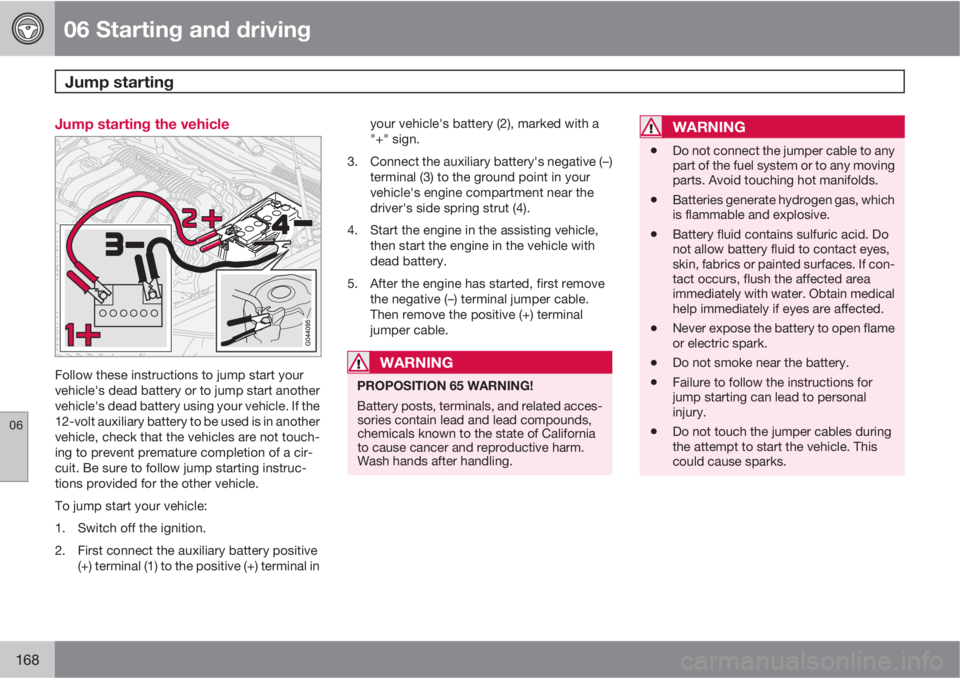
06 Starting and driving
Jump starting
06
168
Jump starting the vehicle
Follow these instructions to jump start your
vehicle's dead battery or to jump start another
vehicle's dead battery using your vehicle. If the
12-volt auxiliary battery to be used is in another
vehicle, check that the vehicles are not touch-
ing to prevent premature completion of a cir-
cuit. Be sure to follow jump starting instruc-
tions provided for the other vehicle.
To jump start your vehicle:
1. Switch off the ignition.
2. First connect the auxiliary battery positive
(+) terminal (1) to the positive (+) terminal inyour vehicle's battery (2), marked with a
"+" sign.
3. Connect the auxiliary battery's negative (–)
terminal (3) to the ground point in your
vehicle's engine compartment near the
driver's side spring strut (4).
4. Start the engine in the assisting vehicle,
then start the engine in the vehicle with
dead battery.
5. After the engine has started, first remove
the negative (–) terminal jumper cable.
Then remove the positive (+) terminal
jumper cable.WARNING
PROPOSITION 65 WARNING!
Battery posts, terminals, and related acces-
sories contain lead and lead compounds,
chemicals known to the state of California
to cause cancer and reproductive harm.
Wash hands after handling.
WARNING
•Do not connect the jumper cable to any
part of the fuel system or to any moving
parts. Avoid touching hot manifolds.
•Batteries generate hydrogen gas, which
is flammable and explosive.
•Battery fluid contains sulfuric acid. Do
not allow battery fluid to contact eyes,
skin, fabrics or painted surfaces. If con-
tact occurs, flush the affected area
immediately with water. Obtain medical
help immediately if eyes are affected.
•Never expose the battery to open flame
or electric spark.
•Do not smoke near the battery.
•Failure to follow the instructions for
jump starting can lead to personal
injury.
•Do not touch the jumper cables during
the attempt to start the vehicle. This
could cause sparks.
Page 205 of 300

07 Wheels and tires
Tire Pressure Monitoring System (TPMS)
07
203
NOTE
•TPMS indicates low tire pressure but
does not replace normal tire mainte-
nance. For information on correct tire
pressure, please refer to the table on on
page 183, or consult your Volvo retailer.
•The tire pressure warning light will not
identify which tire is underinflated. Be
sure to check all four tires.
•A certain amount of air seepage from
the tires occurs naturally and tire pres-
sure fluctuates with seasonal changes
in temperature. Always check tire pres-
sure regularly.
Erasing warning messagesWhen a low tire pressure warning message has
been displayed, and the tire pressure warning
light has come on:
1. Use a tire pressure gauge to check the
inflation pressure of all four tires.
2. Re-inflate the tire(s) to the correct pressure
(consult the tire pressure placard or the
table, see page 183 ).
3. In certain cases, it may be necessary to
drive the vehicle for several minutes at a
speed of 20 mph (30 km/h) or faster. Thiswill erase the warning text and the warning
light will go out.
WARNING
Incorrect inflation pressure could lead to tire
failure, resulting in a loss of control of the
vehicle.
Changing wheels with TPMSPlease note the following when changing or
replacing the factory installed TPMS wheels/
tires on the vehicle:
•Only the factory-mounted wheels are
equipped with TPMS sensors in the valves.
•If the vehicle is equipped with a temporary
spare tire, this tire does not have a TPMS
sensor.
•If wheels without TPMS sensors are moun-
ted on the vehicle, TIRE PRESS SYST
SERVICE REQUIRED will be displayed
each time the vehicle is driven above
25 mph (40 km/h) for 10 minutes or more.
•Once TPMS sensors are properly installed,
the warning message should not reappear.
If the message is still displayed, drive the
vehicle for several minutes at a speed of
20 mph (30 km/h) or faster to erase the
message.
•Volvo recommends that TPMS sensors be
fitted on all wheels used on the vehicle.Volvo does not recommend moving sen-
sors back and forth between sets of
wheels.
NOTE
•If you change to tires with a different
recommended inflation pressure, the
TPMS system must be recalibrated to
these tires. This must be done by an
authorized Volvo retailer or workshop.
•If a tire is changed, or if the TPMS sen-
sor is moved to another wheel, the sen-
sor's seal, nut, and valve core should be
replaced.
•When installing TPMS sensors, the
vehicle must be parked for at least
15 minutes with the ignition off. If the
vehicle is driven within 15 minutes, a
TPMS error message will be displayed.
CAUTION
When inflating tires with TPMS valves, press
the pump's mouthpiece straight onto the
valve to help avoid bending or otherwise
damaging the valve.
Page 228 of 300
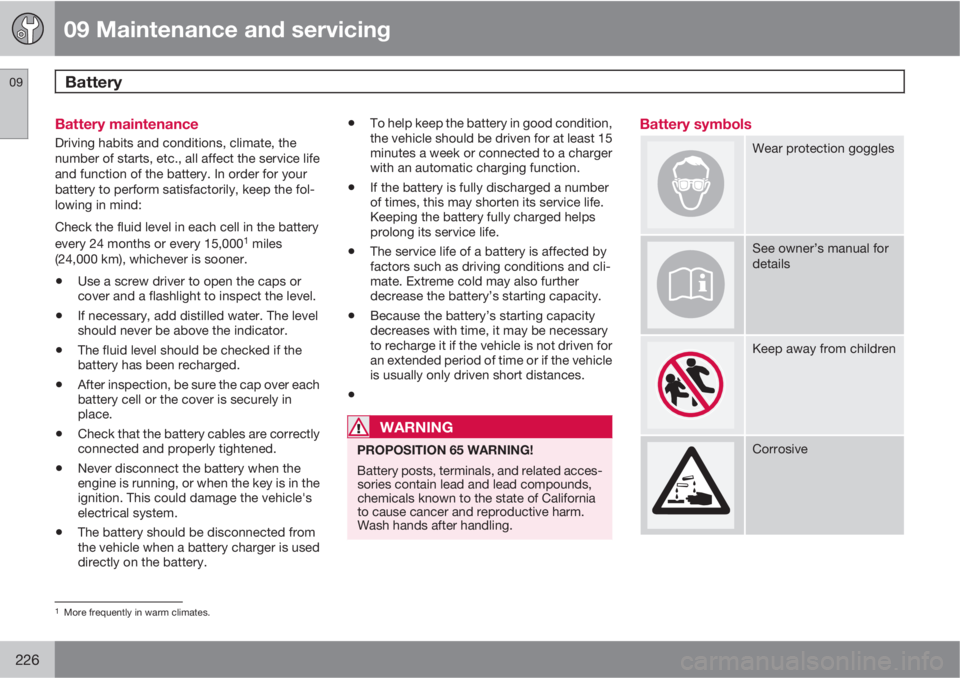
09 Maintenance and servicing
Battery 09
226
Battery maintenance
Driving habits and conditions, climate, the
number of starts, etc., all affect the service life
and function of the battery. In order for your
battery to perform satisfactorily, keep the fol-
lowing in mind:
Check the fluid level in each cell in the battery
every 24 months or every 15,000
1 miles
(24,000 km), whichever is sooner.
•Use a screw driver to open the caps or
cover and a flashlight to inspect the level.
•If necessary, add distilled water. The level
should never be above the indicator.
•The fluid level should be checked if the
battery has been recharged.
•After inspection, be sure the cap over each
battery cell or the cover is securely in
place.
•Check that the battery cables are correctly
connected and properly tightened.
•Never disconnect the battery when the
engine is running, or when the key is in the
ignition. This could damage the vehicle's
electrical system.
•The battery should be disconnected from
the vehicle when a battery charger is used
directly on the battery.
•To help keep the battery in good condition,
the vehicle should be driven for at least 15
minutes a week or connected to a charger
with an automatic charging function.
•If the battery is fully discharged a number
of times, this may shorten its service life.
Keeping the battery fully charged helps
prolong its service life.
•The service life of a battery is affected by
factors such as driving conditions and cli-
mate. Extreme cold may also further
decrease the battery’s starting capacity.
•Because the battery’s starting capacity
decreases with time, it may be necessary
to recharge it if the vehicle is not driven for
an extended period of time or if the vehicle
is usually only driven short distances.
•
WARNING
PROPOSITION 65 WARNING!
Battery posts, terminals, and related acces-
sories contain lead and lead compounds,
chemicals known to the state of California
to cause cancer and reproductive harm.
Wash hands after handling.
Battery symbols
Wear protection goggles
See owner’s manual for
details
Keep away from children
Corrosive
1More frequently in warm climates.
Page 229 of 300
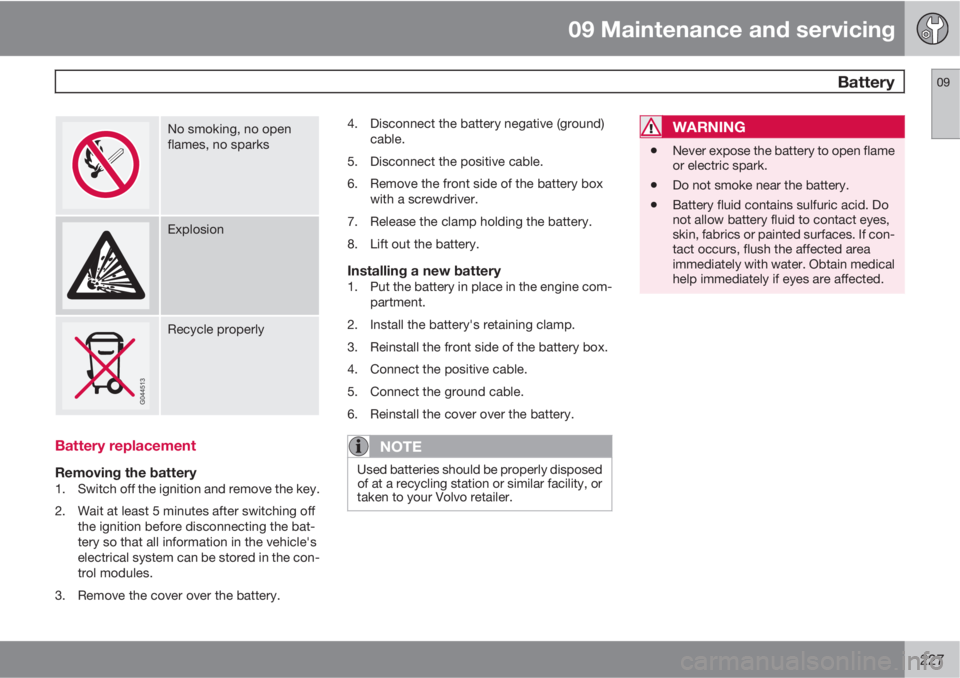
09 Maintenance and servicing
Battery09
227
No smoking, no open
flames, no sparks
Explosion
Recycle properly
Battery replacement
Removing the battery1. Switch off the ignition and remove the key.
2. Wait at least 5 minutes after switching off
the ignition before disconnecting the bat-
tery so that all information in the vehicle's
electrical system can be stored in the con-
trol modules.
3. Remove the cover over the battery.4. Disconnect the battery negative (ground)
cable.
5. Disconnect the positive cable.
6. Remove the front side of the battery box
with a screwdriver.
7. Release the clamp holding the battery.
8. Lift out the battery.
Installing a new battery1. Put the battery in place in the engine com-
partment.
2. Install the battery's retaining clamp.
3. Reinstall the front side of the battery box.
4. Connect the positive cable.
5. Connect the ground cable.
6. Reinstall the cover over the battery.
NOTE
Used batteries should be properly disposed
of at a recycling station or similar facility, or
taken to your Volvo retailer.
WARNING
•Never expose the battery to open flame
or electric spark.
•Do not smoke near the battery.
•Battery fluid contains sulfuric acid. Do
not allow battery fluid to contact eyes,
skin, fabrics or painted surfaces. If con-
tact occurs, flush the affected area
immediately with water. Obtain medical
help immediately if eyes are affected.
Page 230 of 300
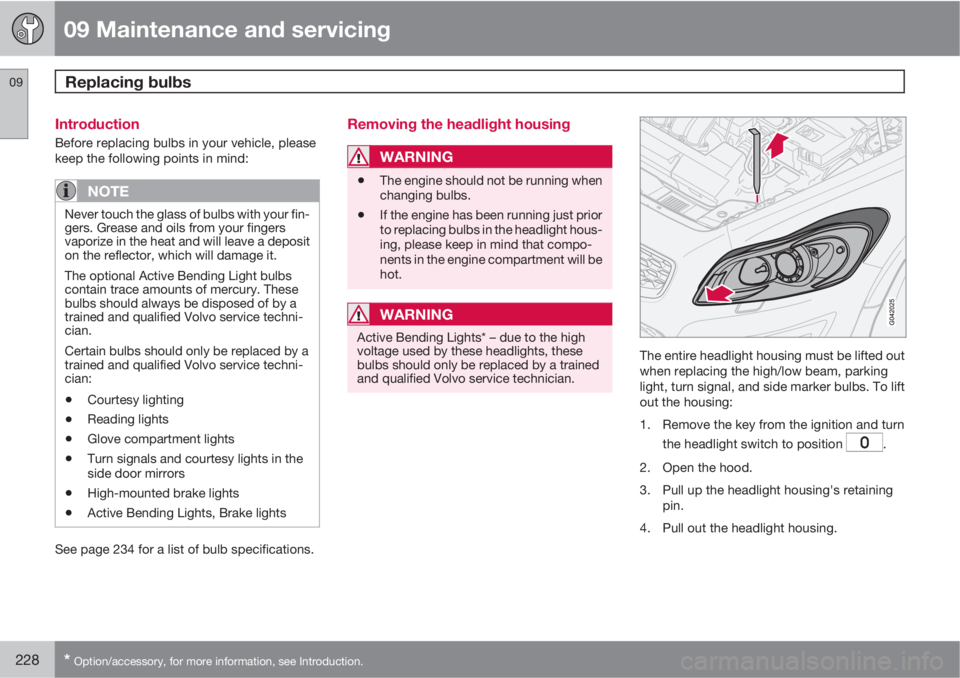
09 Maintenance and servicing
Replacing bulbs 09
228* Option/accessory, for more information, see Introduction.
Introduction
Before replacing bulbs in your vehicle, please
keep the following points in mind:
NOTE
Never touch the glass of bulbs with your fin-
gers. Grease and oils from your fingers
vaporize in the heat and will leave a deposit
on the reflector, which will damage it.
The optional Active Bending Light bulbs
contain trace amounts of mercury. These
bulbs should always be disposed of by a
trained and qualified Volvo service techni-
cian.
Certain bulbs should only be replaced by a
trained and qualified Volvo service techni-
cian:
•Courtesy lighting
•Reading lights
•Glove compartment lights
•Turn signals and courtesy lights in the
side door mirrors
•High-mounted brake lights
•Active Bending Lights, Brake lights
See page 234 for a list of bulb specifications.
Removing the headlight housing
WARNING
•The engine should not be running when
changing bulbs.
•If the engine has been running just prior
to replacing bulbs in the headlight hous-
ing, please keep in mind that compo-
nents in the engine compartment will be
hot.
WARNING
Active Bending Lights* – due to the high
voltage used by these headlights, these
bulbs should only be replaced by a trained
and qualified Volvo service technician.
The entire headlight housing must be lifted out
when replacing the high/low beam, parking
light, turn signal, and side marker bulbs. To lift
out the housing:
1. Remove the key from the ignition and turn
the headlight switch to position
.
2. Open the hood.
3. Pull up the headlight housing's retaining
pin.
4. Pull out the headlight housing.